Dan Pontefract's Blog, page 28
August 7, 2016
That Time I Was Ambushed By Gord Downie
Imagine being unknowingly whisked away in a limousine at 6:45am on a Tuesday morning, told you were going to a radio station studio to interview Gord Downie of the Tragically Hip.
It happened to me in October of 2006.
My infinitely better half, Denise, knowing my passion for all things Hip, entered me into a radio contest without me knowing. A Vancouver radio station, Rock 101, had arranged for Gord Downie to arrive in studio to be interviewed live on the air by what they referred to as a “super fan.”
Apparently, Denise’s application was too good. My profile won the contest. Throughout the process, she—and many friends—managed to keep it a surprise.
Envisage my face on a crisp fall morning as a burly man with a boom mic arrived at the front door, asking if I was “Dan the Hip Head.”
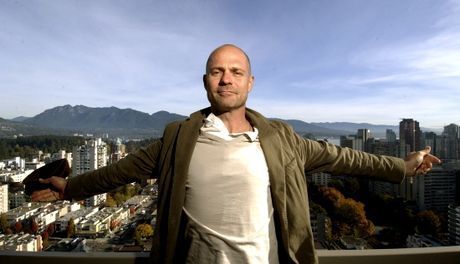 Vancouver – October 10, 2006 (Glenn Baglo)“Pardon?” I asked.
Vancouver – October 10, 2006 (Glenn Baglo)“Pardon?” I asked.
“Are you Dan the Hip Head?” he asked again.
With an incredulous, dumbfounded look quickly sweeping over me, I said, “Umm, yes?”
The rather large man, who I thought was going to whack me with the boom mic, continued, “You’re live on the air with Rock 101 … and you’re going to be interviewing Gord Downie in an hour. How do you feel?”
At that point, I truly thought I was either being Punk’d or the cereal I was previously enjoying had been spiked with hallucinogenic milk.
In the background over my right shoulder, I could hear Denise chuckling with glee. Her plan had worked. The secret had been kept, and indeed I was about to be interviewing Gord Downie. We headed for the limo.
After a short trip to downtown, I entered the studio. To my right, buckets and buckets of Nando’s chicken. I thought that was weird. It was 7am in the morning. To my left was “Bro Jake,” the morning DJ on duty. He looked like the lead singer of a heavy metal cover band. I also thought he had been up for 72 hours straight. His skin was glowing, and not in an Aveeno commercial way.
The crew mic’d me up, gave me a pair of headphones, and we were off. For the next sixty minutes or so, the various on air personalities quizzed me on my Hip knowledge. In all honesty, being a somewhat cerebral guy, I felt like I was Alex Trebek at a party for professional wrestlers.
Just after 8am, my pain came to an end, and Downie entered the studio.
Clearly no one made him aware of the unfolding scenario.
“I’m not sure who is being ambushed Dan, me or you,” he cheekily summarized.
For the next 90 minutes or so, both on air and off, we sat across from one another and, well … chatted. I suspect it wasn’t what the Rock 101 people were expecting. Here they had Gord Downie—of the Tragically Hip in studio—and the band’s biggest “Hiphead” so clearly they were going to talk about beer, hockey and other fraternity-like dialogue.
But we didn’t.
The on-air segments were littered with discussions about lyrics, grammar, the environment (e.g. Waterkeeper) alongside other cerebral bits. When things became too boring for the radio people, the cover band lead singer/DJ found a way to inject potty-mouth humour into the proceedings. Downie took it all in stride, and played along. A “total pro,” if you will.
But what I cherished most were the moments when Downie and I were off-the-air. With a new album titled World Container set to drop in a few weeks, band representatives had given Rock 101 an advance copy of the disc. This gave the radio station a unique opportunity to play a few of the tracks on air before anyone else.
That’s when I really got to chat with him.
When we were ‘off the air,’ and the new songs were playing, the exchanges were both cerebral and touching. And no one was interrupting us.
We talked about Canada, family, children and writing. It was as though we had known each other for years. It was enduring and endearing.
In fact, it was Downie who urged me to get more into writing. “Canada needs more authors, Dan. Find your voice,” he insisted.
Years later, I did. He’s got copies of both my books. I hope to give him a copy of my third in 2018.
I’m still not clear who ambushed whom that day, but one thing is for certain, at the heart of the melt, Gord Downie is a father, husband, son, brother, uncle and friend. He’s a normal guy. He enjoys a good coffee, canoe trips, driving his children to activities and being a respectable citizen to the planet.
He may be a gifted poet, but he really is just a regular man.
I’ll always be thankful for that morning and the ten years ever since.
PS. I have the entire interview stashed away. Here’s a short clip to give you a sample.
http://www.danpontefract.com/wp-content/uploads/2016/08/dangord_part1.mp3
Please consider donating to the:
Gord Downie Fund for Brain Cancer Research
Dan's Related Posts:How I Learned To Think Out Loud Through The Tragically Hip’s Live ConcertsGord Downie and the New Marathon of HopeCanada’s Poet Laureate, Gord DownieWalking the Talk of Being an Open Leader With My ChildrenDid ‘The Beatles’ actually collaborate or were they working in silos?
July 30, 2016
Gord Downie and the New Marathon of Hope
Thirty-six years ago I watched Terry Fox run by me near Hamilton, Ontario. I was nine-years old. Both that moment and Terry’s tenacity–a man running across Canada with an amputated leg to raise money for cancer research–had a profound impact on my life. Rarely does a week go by when I don’t think about Terry. Indeed his gift is forever green.
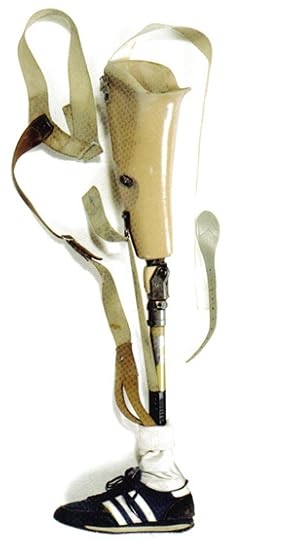 I flew from Victoria to Edmonton the other day–with my 13 year-old daughter–to catch another live show of The Tragically Hip’s Man Machine Poem tour. Four concerts in, I’m noticing a pattern.
I flew from Victoria to Edmonton the other day–with my 13 year-old daughter–to catch another live show of The Tragically Hip’s Man Machine Poem tour. Four concerts in, I’m noticing a pattern.
Canada has itself another “Marathon of Hope.”
The “Marathon of Hope” was the title given to Terry Fox’s quest back in 1980. He did so not for himself, but for others. Of course, running on one leg across Canada is no easy feat. Were it not for a recurrence of cancer, our national hero would have dipped his prosthetic leg into the Pacific Ocean at some point later that year and reached his goal.
But he didn’t. Terry passed away on June 28th, 1981, one month shy of his twenty-third birthday due to cancer. His selflessness was incredible. His determination unbridled.
Gord Downie isn’t quite running marathon a day, but I feel like I’m that 9 year-old boy again watching another hero traverse across Canada. I’m in awe. I’m flabbergasted that he’s doing it in the first place. Performing a concert, to thousands, every other night across Canada for a month, cannot be easy. Downie has terminal brain cancer. Let that sink in for a second.
Courage? Of course. But the fact he has gone public about the disease and decided to travel across Canada to sing and dance on stage with his four band mates is incomprehensible. He could have turtled. Cocooned. But he came out swinging.
I’m four shows into this tour. I am noticing something rather unique with Downie’s stage presence.
Acceptance, transparency and love.
These are the traits I have picked up on with Downie’s new “marathon of hope.”
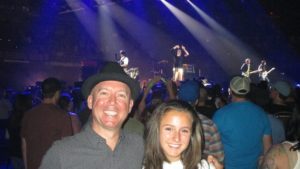 The tour started in Victoria. Nervous tension was evident early on during the show. It was throughout the audience as well. Perhaps due to the shiny metallic suits he adorned, Downie loosened up and began to reflect. When introducing “At The Lonely End Of The Rink,” a song about being a hockey goalie as a youngster and how his father would sit near him during games, Downie said, “This one’s for my dad. He’s gone. Shit happens.” It might have been his first step during this tour of publicly accepting his own eventual fate.
The tour started in Victoria. Nervous tension was evident early on during the show. It was throughout the audience as well. Perhaps due to the shiny metallic suits he adorned, Downie loosened up and began to reflect. When introducing “At The Lonely End Of The Rink,” a song about being a hockey goalie as a youngster and how his father would sit near him during games, Downie said, “This one’s for my dad. He’s gone. Shit happens.” It might have been his first step during this tour of publicly accepting his own eventual fate.
By the Vancouver shows, during certain songs and specific lyrics, Downie began physically pointing to himself as if to say, “I know, I know, I’m the guy holding the elephant in the room. But let’s just get on with things and have a good time tonight.” The song, “Tired as Fuck,” was a classic demonstration of Downie literally pointing out his current state, in a self-deprecating manner.
But if acceptance is one characteristic Downie is demonstrating in his “marathon of hope,” so too is transparency.
If you have ever been to a Tragically Hip concert you will know Downie slips into an alter ego on stage. Through 30+ years of performing, his stage presence is not only legendary, it’s downright mythical. Rants, poetry and lyrical quips were always the norm. If there was one thing he seemed to hate, it was a straight answer to a song’s origination or intent. That is, no song was introduced in simple terms. He’d either make something up or introduce the song in a way that required a doctorate in philosophy to understand.
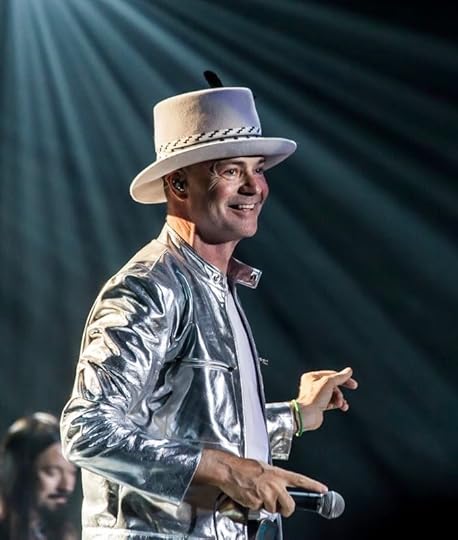 On this what may be the last tour of the band, Downie has become far more transparent. During the second Vancouver show, he introduced the song “Toronto #4” with, “Here’s one for my grandmother. She ain’t around no more.” The song was a musical eulogy of sorts released back in 2000.
On this what may be the last tour of the band, Downie has become far more transparent. During the second Vancouver show, he introduced the song “Toronto #4” with, “Here’s one for my grandmother. She ain’t around no more.” The song was a musical eulogy of sorts released back in 2000.
“This is for my sister, Charlotte,” was how the 1991 song “Fiddler’s Green” got introduced, a tune written by Downie for his sister’s son (and his nephew) who died suddenly at the age of five.
I’ve been to well over 100 concerts since 1991, and never have I seen Downie so transparent. It truly is touching.
The final trend I am noticing during the first four shows is love. It began on the first night in Victoria. Toward the end of the show, at the conclusion of an encore, Downie went to each of his four friends in The Hip and kissed them. It was beautiful. It was a truly loving gesture. Sitting in the audience with my wife, I lost it. Tears streaming down my face.
The same happened in both Vancouver shows. Heart wrenching.
During “Grace, Too,” on the first Vancouver night, there were a few seconds during the song when Downie’s own heart melted. It was a moment with the audience when he looked at the crowd as if to say, “I hear you, I get it, I’m sorry, and I love you.” He bathed in that moment, then quickly dried off and returned to pantomiming a golf swing.
In Edmonton, his love for the audience continued. Tears now streaming down his own face, at the end of the night he said: “Thanks for coming to our first show, all of you. This has been our first show. We arrive alive. You take care of each other. Right? Right?”
 I was on the floor with my daughter, 5th row in seats 1 and 2. I looked to my left and there were two medical attendants, male and female, standing against a wall. Both of them, uncontrollably teary-eyed.
I was on the floor with my daughter, 5th row in seats 1 and 2. I looked to my left and there were two medical attendants, male and female, standing against a wall. Both of them, uncontrollably teary-eyed.
Naturally, so was I.
Downie didn’t have to tour across Canada. He didn’t have to raise awareness for glioblastoma, the rare form of brain cancer he has been saddled with. But like Terry Fox, he is out there, singing and dancing a new “marathon of hope” across this country he so dearly loves. Not out of selfishness, but selflessness.
Full of acceptance, transparency, love … and grace, too.
PS. Here is Gord at the end of the first Edmonton show.
Please consider donating to the:
Gord Downie Fund for Brain Cancer Research
Dan's Related Posts:Canada’s Poet Laureate, Gord DownieTerry Fox, My HeroHow I Learned To Think Out Loud Through The Tragically Hip’s Live ConcertsWalking the Talk of Being an Open Leader With My ChildrenTwo Very Incredible & Courageous Women
July 26, 2016
How I Learned To Think Out Loud Through The Tragically Hip’s Live Concerts
In this the era of pervasive short-term thinking, a surprising lack of thinking (see Pokémon GO inanity) and a general loss of critical thinking, I found myself “thinking” about my favorite band, The Tragically Hip.
The Hip—the affectionate and arguably ironic nickname of the group—is a thinking person’s band.
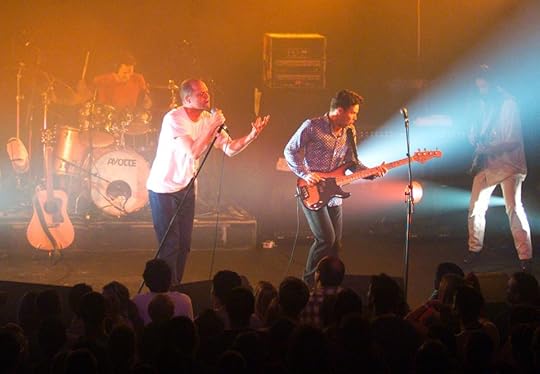
Copyright 2002 The Associated Press
Over a 30-plus year career, they have woven their mercurial version of “the blues” into 13 studio albums. If you were looking for simple chords and approachable lyrics, The Hip would be last on your list of music choices. In 2014, Rolling Stone listed the band as one of 20 Hugely Popular Musicians Who Haven’t Gotten Famous in America (Yet). The band has sold more than eight million albums in their native Canada but in the U.S., for the most part, crickets.
But as I reflected on the band this week, I began to think about the 100+ concerts I’ve seen over a 25-year period. My first show was in August of 1991 in Montreal. At that first gig, I was taken aback by both the stage presence of its lead singer, Gord Downie, as I was by the intoxicating vibe that emanated from Paul Langlois and Rob Baker (guitarists) as well as Gord Sinclair and Johnny Fay (rhythm section).
As the shows piled up over the years, I began to notice a trend.
This band was actually thinking out loud each night they went to work. On stage.
Musical acts need, well, music. If there’s no music, there’s nothing to sell. Nothing to tour with. Nothing to sing or play. Some acts will write the music in the confines of a hotel room, a music studio, perhaps in a dressing room. Maybe they write songs in their home.
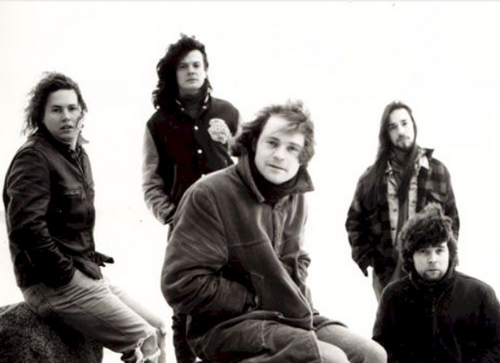 The Tragically Hip are much different.
The Tragically Hip are much different.
While their concert setlists range between 20 and 26 songs, often there were more songs played. How?
First, there is Gord Downie. Known as Canada’s unofficial poet laureate, he can be seen reciting words and phrases (even poems) before, during or after a song is played live by the band. In fact, what he’s doing is working out lyrics for future songs. Live. On stage. Those snippets may never see the light of day, but if you’ve followed their career as I have over a 25-year period, you often see those phrases appear in an album months or even years later.
Second, there is the band itself. It’s one thing to start waxing lyrical while on stage (as Downie does) but it’s another to begin building the makings of a new song, right in the middle of an existing one.
Most songs that a musical act writes are made up of the following structure:
• Verse / Chorus / Verse / Chorus / Bridge / Chorus
Imagine when it comes time for the bridge, a band trying to work out—live on stage—an entirely new song for potential inclusion in an upcoming album. Coupled with new lyrics and/or poetry from its lead singer, you get some amazingly original yet “thinking out loud” experiences.
Put simply, The Hip is a band that works and thinks out loud.
Perhaps the best way to explain this “a-ha” moment of mine is through an example.
It was August of 1996. The Hip was touring their latest album, Trouble at the Henhouse, which had released three months prior. Vacationing in southern Ontario, Denise and I made the four-hour drive to Cleveland, Ohio. The venue was the Odeon, a magnificent emporium of sound and soul. There were less than a thousand of us in attendance. Remarkably, in the middle of the dance floor I bumped into an old school friend. He lived in Montreal. He drove further than I did. Crazy Canadians.
Through the first eight songs, there was ample adlibbing from Downie to fill a new album of lyrics. The cerebral circus was in full swing. The ninth song into the show, however, was At The Hundredth Meridian, a tune that clocks in at just under four minutes on the album version. In Cleveland that night, it lasted roughly 13 minutes.
Sure enough, when it came time for the bridge, the band went into another musical orbit. There were bits of three different songs that would eventually end up on the next album—released two years later—while they also managed to play another full song that still has never been released. The magic in the entirety of that song was watching the band mates give each other physical cues, building off one another to extend the moment. In total, there were bits of six different songs played in those 13 minutes. But only one was officially At The Hundredth Meridian.
Throughout their career as live musicians, The Hip were never scared to try, to meander, to see where their “out loud thinking” might take them. Was it brave? Maybe. What it taught me—and the countless times I have seen it in action—was not to be afraid to put your unfinished thoughts out there in the public domain.
At work (in my real job) I have learned to float ideas, not to bottle them up. Those ideas could surface through blogs, meetings, discussion forums, and so on. Ideas need oxygen. Ideas need an imperfect ear. Ideas need to see the light even if the moment seems dark and confusing.
In my writing as an author, I have learned to use my personal blog to try out ideas, concepts and general thoughts. They don’t all make sense—they don’t all make it to a book or an official article—but it’s most definitely a ‘thinking out loud’ vehicle.
After all these years, after seeing more concerts than I can count, my thanks go out to The Hip for mastering the art of thinking out loud. Indeed, it is a beautiful thing.
Please consider donating to the:
Gord Downie Fund for Brain Cancer Research
Dan's Related Posts:Canada’s Poet Laureate, Gord DownieDid ‘The Beatles’ actually collaborate or were they working in silos?Steve Jobs – My Favourite BeatleI’m Showing My Work … My Next Book Is PostponedApple CEO Tim Cook and his Moment of Open Culture
July 24, 2016
Canada’s Poet Laureate, Gord Downie
If you happen to be Canadian, Gord Downie is pretty close to being a household name. Like Gretzky. Or Trudeau. Bieber. Even Tim Horton.
If you’re not from Canada, let me help paint a picture of this iconic musician, poet and free market capitalist through a “forest of whispering speakers,” if you will.
America has Bruce Springsteen, Bob Dylan and Eddie Vedder. Ireland has Bono. William Blake was England’s answer to lasting prose and song.
Canada has Gord Downie. There is no one like him.
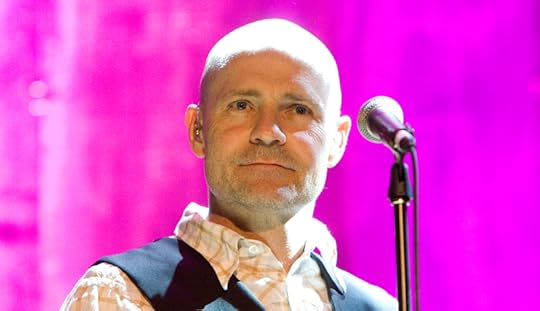
The lead singer and lyricist of The Tragically Hip—a band that commenced delivering their mercurial version of “the blues” in 1984—announced on May 24 he had been diagnosed with terminal brain cancer. Glioblastoma (GBM) quickly surged to the top of the search engine charts that day across Canada producing more hits than from the 8 million albums the band has sold over their career.
As a Canadian I can assure you our nation’s heart stopped, eyes welled and ankles became wobbly when the news was digested. En masse, Canadians were quickly in disbelief and outwardly despondent, now in unison “at the lonely end of the rink.”
I was in Denver of all places. Roughly ninety minutes before going on stage to deliver a keynote presentation, I received word like everyone else. Terminal brain cancer? It can’t be. This is Gord Downie. He’s only 52-years old. He’s Gord Downie!
Seated in a green room, I could not stop crying.
Showing true Canadian grit if not unabashed determination, the band announced not only Downie’s cancer diagnosis, but the following day a summer tour.
A tour?
A tour.
Not a detour. Not a faitour. A tour. A tour across Canada’s majestic and varied contour celebrating their latest album, Man Machine Poem.
Back in Denver, I had to stop crying. If Downie and team were going on tour, I could at least get on stage and deliver my speech. If he had demonstrated a higher purpose, surely I could speak about purpose.
But this is precisely what separates Downie from others. He is a patriot but he is also our compatriot. He is resilient, yet humble. He’s just as comfortable shopping at Canadian Tire as he is pantomiming a long paddle in his big red canoe while on stage with his Hip bandmates. He is as likely to dote over his children (Apple, Zippo and Metronome, of course) and wife (Lord Angora) as he is sitting alone in a park, jotting words and sentences down in his trusty journal with his 400 pound feather. (That’s what he calls his pen.)
He is a lot like Terry Fox, Canada’s “Marathon of Hope” hero. Resilient, yet humble. Determined, yet affable. A national treasure. Canadian, through and through.
Downie has chronicled his observations in life like no other. His lyrics are draped in symbolism and verisimilitude. Omnipresent, however, is not only a love and curiosity for his country but the relationship he (and we) have with it, and most importantly, with one another.
If you’re not from Canada—even if you’re not that into music—you probably have heard of Springsteen or Bono. Springsteen sings about the American returning from Vietnam in Born in the USA. Bono laments about a horrible chapter in Ireland’s history in Sunday Bloody Sunday. No matter your nationality, those songs are likely etched into your memory.
If you’re not from Canada it’s very unlikely you’ve ever heard Downie’s synopsis on Canadian figures and events, his observations of relationships and life.
In Daredevil, Downie highlights individuals (some say crazies) who purposely plunged over Niagara Falls in a wooden barrel. Born in the Water describes the inanity of a mayor in Sault Ste. Marie, Ontario who made a unilateral decision to turn a bilingual city into an English-only one. Something On delved briefly into the ice storm that hit Eastern Canada in 1998. Want to learn about a cholera outbreak in Canada? Listen to Lake Fever. Downie pays tribute to Canada’s peace keepers and soldiers in The Dark Canuck.
His lyrics may overtly point out Canadian artefacts—such as Mistaken Point, Newfoundland or Moonbeam Ontari-ari-o in Fly—but often it takes twelve listens and several readings of the lyrics to sort out any kind of reference or meaning. “Terry’s gift is forever green, It got me up, back on the scene,” for example, pays a hoser homage to the aforementioned Terry Fox in The Inevitability of Death and Downie’s reverence for Terry’s own battle and resilience with cancer.
And now, like Terry, there is an unexpected yet expedited inevitability of death for Downie. How tragically unhip.
But the lyrics and poetry are but one side to Downie. He is, after all, a music lover. It is this love that has seen countless Canadian (and non-Canadian) bands added to various Hip tours. These bands have even found their way into the lyrics. Joel Plaskett, Odds, Sloan, City and Colour, Sam Roberts Band, By Divine Right, Hey Rosetta!, The Trews, Broken Social Scene … just a smattering of the musical acts he and the band have assisted over the years.
My first live concert with The Hip was August 9, 1991 in Montreal. It was an awakening of sorts for me. It soon became an itch that had to be scratched as often as was possible. The Hip were touring their second full-length album called Road Apples. When the band took the stage, an inexplicable cosmic connection formed. It was live, and it was between us. Unless you have witnessed the band in concert, it becomes very difficult to describe. Pulsating duelling guitars courtesy of Rob Baker and Paul Langlois. A rhythm section headed by Gord Sinclair and Johnny Fay that puts any band to shame. It was the blues on an anabolic steroid.
And then there was Downie, the former hockey goalie and curious frontman. Picture a hulking ectomorph who dances and pantomimes on stage as if auditioning for Juilliard. In parallel, he rants, recites poetry and adlibs tunes within, before and after almost every song on the set-list. Who does that?
It wasn’t only unique, it was downright inspiring. I became transfixed by the unfolding scenario. I was hooked. He was part clown, part poet, part philosopher, part dancer, part Martian. I said to myself, “This guy’s got courage.” Sure enough, the band released a song the following year called Courage.
Like a few other Canadian fans, I suppose I could be coined a “Hip Head.” I’ve been to countless shows since 1991 in Canada, the US and Europe. I stopped counting at the century mark. I’ve seen The Hip in a field, tavern, bar, gymnasium, cinema, backyard, living room, bowl, pier and even a zoo. I’ve attended Downie’s solo shows, poetry readings, and a wonderful compilation and concert series with The Sadies.
They opened for the Rolling Stones. I thought The Hip stole the show. Mick Jagger had nothing on Downie. The rest of the band ran musical circles around Keith and the boys.
Any time someone asks me what my favourite show is, I reply, “The last one.” Seeing The Hip live in concert is an unorthodox experience. It quenches an occasional need of mine. The need for a cerebral sonic circus.
This summer, if someone asks me the question again, I’ll respond with, “The last one,” just like I always do. My first show this summer is July 22nd in Victoria. I’ll say it five more times throughout the tour culminating with the last concert on August 20th in Kingston. No one from The Hip camp has confirmed Kingston will be their last ever live performance, but if it is, I’ll be there mesmerized and in utter awe, much like I was some 25 years ago in Montreal. Indeed, a cerebral sonic circus. You can watch it live on CBC if you don’t believe me.
“What’s your favourite show, Dan?”
“The last one,” I’ll say. Truthfully, like many others, I’m hoping August 20th doesn’t become my final answer.
As Downie charts a new but imminent path to the waterfall with his 400 pound feather and trusty notebook intact, I’ll end with a short thank you.
Thank you for teaching me to be at ease with being me. Thank you for inspiring me to become a better autodidact. Thank you for making me my oldest daughter’s “favourite teacher.” Thank you for pushing me to drown in the word—to find treasure or worse—all while honing my own handcrafted 400 pound feather. Thank you for a lifetime of memories … and love.
Indeed love will be the longest thing that we do.
You will be known, you will be loved? No, Gord, you are known and you are loved.
Life may be too short for bad coffee, but death is too long for terrible poetry.
Thank you for being our country’s poet. May we all be at ease with ourselves.
Please consider donating to the:
Gord Downie Fund for Brain Cancer Research
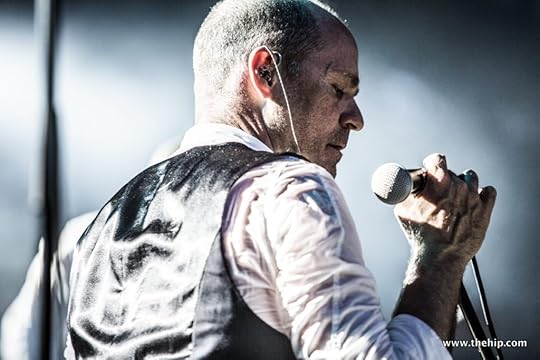
Dan's Related Posts:Terry Fox, My HeroWalking the Talk of Being an Open Leader With My ChildrenDid ‘The Beatles’ actually collaborate or were they working in silos?We Can Put The Word ‘Can’ Back In CanadaSteve Jobs – My Favourite Beatle
July 11, 2016
Evolution of the Chief Learning Officer
There I was, having an engaging conversation with a fellow Chief Learning Officer (CLO) at a conference lunch, when things began to take a decidedly status quo turn.
“As long as I show increases in the Learning Management System metrics and with the course evaluations, my C-Suite doesn’t care about anything else.”
I sat there stunned, aside from an audible yet incredulous gasp escaping from my mouth.
“Surely that’s not how you’re running the team?” I asked.
The CLO, unfazed, looked me square in the eyes and said:
“Of course I am. If that’s all the C-Suite care about, why should I rock the boat?”
To hold the position of Chief Learning Officer, CLO’s ought to be operating in a much different fashion than what I have described above. If, for example, a CLO has no sense of ‘why’ they’re in the position in the first place, how can we expect them to deviate from an LMS and course evaluation mindset? If the CLO is in the role because they like the perks of a fancy ‘Chief’ title and larger salary, they have completely missed the point of ‘why’ the role exists in the first place.
But more importantly perhaps, the C-Suite has to begin rethinking what the actual purpose is to the CLO role itself.
C-Suite executives ought to know that engagement scores continue to remain at anemic levels, hovering around the 30 percent mark since 2000. In part, this is because employees have not discovered a purpose mindset in their roles at work. Coupled with an organization that is often fixated on profit and power, it’s no secret why disengagement is rampant in today’s working world.
To curb this, it’s my belief that the C-Suite—in particular the CEO or COO—ought to be empowering an organization’s CLO to think like a Chief Engagement and Purpose Officer. That is, the CLO ought to not only be responsible for ‘learning’ but for the organization’s culture and purpose strategy. This newly redefined CLO will now hold the keys to a more engaged organization, one replete with an army of purpose mindset employees. If they demonstrate leadership by helping more of the organization reach purpose in their roles, there is no telling what heights the organization may reach.
The role of a CLO is to help employees right across the organization define their own sense of purpose. When an employee discovers their personal purpose and (ideally) it is lockstep with the role they perform in the organization, both the employee and the firm benefit.
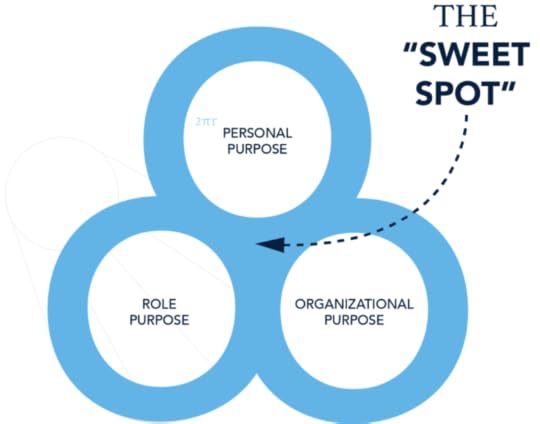 I have discovered there are three types of purpose:
I have discovered there are three types of purpose:
Personal Purpose: What motivates someone in life; their “why.” An individual’s values, experience and beliefs inform personal decisions and actions.
Organizational Purpose: Why the organization exists. An organization’s principles, ethics and culture inform its ways of operating.
Role Purpose: Why a role exists in the organization. To achieve its goals and objectives, an organization establishes a variety of roles to support its mission.
Ultimately, employees will exhibit one of three different role mindsets when they are working:
Job Mindset. Performing transactional duties in return for compensation and not much else.
Career Mindset. Focused on increasing one’s career girth by advancing salary, title, power, team size and/or span of control.
Purpose Mindset. Passionate, innovative and committed to a meaningful and engaging workplace that serves and benefits all stakeholders.
If the CLO can help employees recognize their own personal purpose, understanding what the organization’s purpose is, they might have a greater chance at reaching the purpose mindset in their roles. For those that are having difficulty—either trapped in a job or career mindset—the CLO can take appropriate actions to help employees shift into the purpose mindset. It’s an action that can involve all of the tools at the disposal of a CLO, including formal, informal and social learning, coaching, assessments, and so on.
What steps can the C-Suite take to change the description and responsibilities of a CLO?
First, the CLO must stop acting like an order taker. CLO’s are not simply there to produce courseware. They are more than a factory that feeds the LMS. The C-Suite members are culpable for this type of thinking. If they are only asking for the CLO to deliver metrics like “number of hours trained” or “number of courses delivered” they are ultimately aiding and abetting a disengaged and purposeless organization. The C-Suite must measure the success of a CLO not by courses or hours, but by engagement scores and the number of employees demonstrating the purpose mindset.
Second, the C-Suite ought to start asking the CLO to act like a leader of purpose. Have the CLO declare their own personal purpose statement and help others on the C-Suite and across the organization understand why everyone is in business (and in their role) in the first place. A leader of purpose is open, collaborative and transparent demonstrating a penchant to support all stakeholders, not simply profit seekers or shareholders.
Third, encourage the CLO to start building out and delivering a role purpose strategy and learning program. This comes in the form of many types of learning (formal, informal and social) and is intended to help employees see the difference between a job, career and purpose mindset.
In summary, how many individuals in today’s organizations are empowered to put their hearts in their role and to go above the call of duty at work?
I believe this is the (partial) responsibility of the CLO.
Now, it’s up to the C-Suite to redefine what the CLO and its office really is about and to make the change happen.
Dan's Related Posts:Defining A Leader’s Duty Of CareThree Types of Workplace MindsetsLo-Tech Talk #2: The Leaders Guide to The Purpose EffectA Few Easy Steps For Entrepreneurs To Take To Enact A Higher PurposeDownload Chapter 1 of “The Purpose Effect” For Free
July 9, 2016
Download Chapter 1 of “The Purpose Effect” For Free
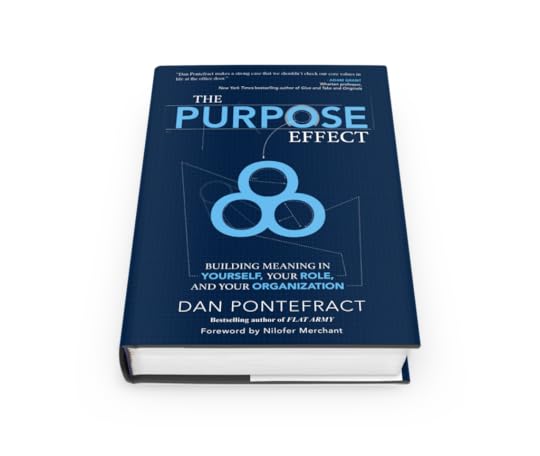 Click here to download the Introduction and Chapter 1 of my new book The Purpose Effect.
Click here to download the Introduction and Chapter 1 of my new book The Purpose Effect.
Click here to order the book on Amazon.
More information on the micro-site.
Reviews
“It’s great to have this book to add to the conversation about deeper ways to improve the poor levels of employee engagement that exist inorganizations today. Too often, we only hear about the “corporate ROI” from working to improve engagement, and fail to talk about the personal impact to people from working in environments that force them to leave their passion and values at the door. With The Purpose Effect, we can add a new dynamic to move the conversation forward about the shared ownership for engagement.”
– Actionable Books
“The Purpose Effect provides a roadmap for how we can develop personal purpose in our lives, in the organizations we work for, and in our specific role within an organization. Pontefract powerfully shows why we need to pay attention to each of these in relationship to one another.”
– 800-CEO-READ
“How do you find a personal purpose and a business purpose that are in sync, to be the driver of business success, as well as your own happiness? I just finished a new book, “The Purpose Effect,” by renowned author Dan Pontefract, that provides a good framework and background or doing just that. I recommend his tips for creating and maintaining that sweet spot.”
– Martin Zwilling, Forbes
“Advocating corporate social responsibility, The Purpose Effect: Building Meaning in Yourself, Your Role, and Your Organization, by Dan Pontefract, is an inspiring how-to guide that proposes a plan to move away from the all too common us-versus-them mentality toward building more collaborative and productive relationships between organizations and employees.”
– Foreword Reviews
“Is Pontefract’s work the end of the search for engagement? Not likely, but it does move us along the journey to find meaning in our work, and that can’t be a bad thing.”
– The Bellingham Business Journal
Dan's Related Posts:Free Download of Chapter 1 – The Purpose Effect Lo-Tech Talk #4: The Sweet Spot of PurposeThe Electrocardiogram of PurposeLo-Tech Talk #1: Introduction to Personal PurposeLo-Tech Talk #2: The Leaders Guide to The Purpose Effect
July 7, 2016
A Shooting Dallas Star
by Dan Pontefract
Love your self; our humanity will prosper.
Love your humanity; neighbours will reciprocate.
Love your neighbour; the community gathers strength.
Love your community; society offers hope.
Love your society; and we might all shine as one.

Dan's Related Posts:We May Not AlwaysTalent Development Isn’t Just About TrainingInstead of Inbox Zero, How About Outbox ZeroThe Purpose Effect Launch PartyIn Victim
July 6, 2016
A Few Easy Steps For Entrepreneurs To Take To Enact A Higher Purpose
 Since the time of the ancient Greeks, the concept of a “higher purpose” has been discussed. As the German professor Ernst Curtius once wrote, “The whole tectonic art of the Greeks is consecrated by a higher purpose.”
Since the time of the ancient Greeks, the concept of a “higher purpose” has been discussed. As the German professor Ernst Curtius once wrote, “The whole tectonic art of the Greeks is consecrated by a higher purpose.”
When you think about it, we might coin those ancient Greeks as the first real examples of startups. During what some call the “classical era,” the Greeks were an entrepreneurial cohort, spanning the early 5th century BC to the death of Alexander the Great in 323 BC. They invented things we take for granted today, including the Olympic Games, mythology, philosophy, and cartography. They even invented the odometer. As they invented—as they ran their Greek startups—they did so thinking about others. They acted to better society, not solely the owners of the ideas.
But their inventions, their entrepreneurial spirit, their philosophy of sharing … it all came down to a universal truth:
An organization’s purpose is not to serve those who rule; it exists to serve all stakeholders.
Take for instance Mana Ionescu. She took a deep breath one day, and asked herself, “What am I really doing?” Life, her career and the company she was working for had become too transactional. The creativity was minimal. Ionescu knew who she was, but the organization that employed her was lacking a higher purpose. “There must be more to my working life than just sitting here making money, fixating on profit and not actually making an impact,” she mused to herself.
Ionescu set out to fix things. She quit her role and started Lightspan Digital, a digital marketing company based in Chicago. In her eyes, too many businesses only see themselves through the lens of profit, whereas in reality she believes there should always be a higher purpose to being in business. Ionescu had observed that too many firms are solely “win” organizations, preoccupied with profits and revenues. She believes organizations should strive to become “win-win-win.”
The three “wins” include:
The necessity to make a profit and deliver value to customers.
The individuals that make the business successful (team members, suppliers, buyers).
Society, including the environment and members of the external community.
When she created Lightspan Digital, the value proposition of the firm was not solely on profit. It was balanced between her “win-win-win” stakeholders theory. The purpose statement for Lightspan Digital developed in partnership with her team portrays these beliefs:
To deliver clear, simple and direct digital marketing solutions. We believe in social media marketing done with purpose, not just for the heck of it.
LSTN, a company based in Los Angeles that produces and sells high-quality wooden headphones, is another example to consider. During its startup days, the co-founders’ mission was to build a company that would “create global change by providing high quality products that help fund hearing restoration and spread awareness for the global problem of hearing loss and hearing impairment.” In fact, its co-founders wanted to “create something that could change the world.”
This is a powerful way to incorporate purpose into your mission, your culture, and how you operate. So, for every pair of headphones LSTN sells, the company commits to helping restore hearing loss for someone in need. Indeed, this is a higher purpose. It was developed with stakeholders in mind, not solely the owners or entrepreneurs.
When purpose is defined and enacted, the benefits begin to pile up as well. Prospective employees see you as an attractive place to work, while internal employee engagement can reach lofty heights. When employee engagement goes up, customer satisfaction and loyalty correspondingly increase. In fact, Queen’s University found customer satisfaction levels are 30 percent greater and team productivity rises 15 percent when employee engagement is high.
So, when your startup acts with a higher purpose, it’s easier to gain traction, and it definitely pays off: Your employees are more engaged and productive, and your customers remain loyal to you
Here are some steps you can take to enact higher purpose in your firm today:
Work together to declare your organizational purpose. By establishing a purpose-first culture that serves the interests of all stakeholders, your startup likely will have far greater buy-in from your employees to achieve its mission and objectives. When your employees are bought in and able to demonstrate purpose in their role, research shows that organizational benefits begin to quickly accrue.
Serve all stakeholders. It is one thing to declare your organization’s higher purpose, and it is another to carry it out each and every day. Lightspan Digital and LSTN decided to act with a higher purpose in all their actions. It cannot be a part-time mission to serve all stakeholders. As you build out the organization’s new purpose, you must then ensure you carry it out in all of your actions, serving all stakeholders.
Develop a purpose scorecard. By restating how your startup is going to operate—with a higher purpose—you can set targets and publish the results by using a scorecard (see our scorecard below). By committing to serve all stakeholders, the scorecard is a way to track how you are operating with purpose against five key areas: customers, employees, community, society and profitability. Set targets for each and weight each one accordingly. Publicly publish the scorecard on your website. Your customers will appreciate and become loyal to your commitment to serve all stakeholders.
Maybe we should all become a little more Greek, too.
Dan's Related Posts:The Purpose Effect ScorecardThree Tough Questions Answered About PurposeLo-Tech Talk #3: Organizational PurposePurpose: The Word of 2016Inspiring CEO Quotes About A Higher Purpose
June 24, 2016
The Purpose Effect Scorecard
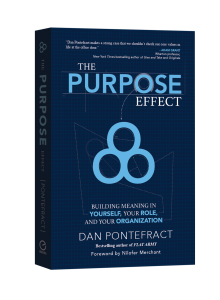 My latest book, THE PURPOSE EFFECT, has been out in the wild for about six weeks.
My latest book, THE PURPOSE EFFECT, has been out in the wild for about six weeks.
Toward the end of the book I introduce ‘The Purpose Effect Scorecard‘ a means in which an organization can publicly state and track how it is serving all of its stakeholders.
For me, stakeholders are the reason an organization is in business in the first place.
There is a fairly easy way to summarize all of the stakeholders the organization ought to be serving. If it is putting its customers first, it does so through its team members (who are ideally engaged, demonstrating personal and role-based purpose) who then aim to assist the community in which they live, and the society they are a part of. Additionally, the organization will provide a return to owners and/or shareholders where applicable. Of course, this is an outcome of a properly aligned strategy that addresses the needs of other stakeholder groups before shareholders. Thus, there are five key stakeholders an organization ought to be serving:
Customers
Team Members
Community
Society
Owners/Shareholders (if applicable)
For each of the five stakeholders an organization now aims to serve, I recommend setting targets and to then publicly publish the results to a new dashboard website. This is not a Corporate Social Responsibility (CSR) document or report. It is a thoroughly defined and proactive set of targets and measures that are established, which the organization holds themselves accountable to on a quarterly and annual basis. CSR documents tend to be reactive, and, too often, toothless. A cumulative score or target can be created from all targets measured against all stakeholders. This is applicable for public sector, not-for-profit and for-profit entities as well.
The targets that are set annually and then tracked quarterly (and publicly published) ought to include the following:
Customers: customer satisfaction scores through various factors including reliability, responsiveness and relationship. Other metrics could be devised by the organization.
Team Members: engagement scores and sub-drivers, diversity breakdown, acts of internal recognition, positional changes/promotions and learning & development expenditure.
Community: team member volunteer hours, organizational philanthropic investment, in-kind donations, number of community members impacted, etc.
Society: CO2 and greenhouse gas (GHG) reductions, water utilization/reuse, energy consumption/redesign, material consumption/lessening. Other examples from the Dow Jones Sustainability Indices-DJSI-could also be utilized.
Owners/Shareholders (applicable to for-profit firms): Profitability, revenue and shareholder return (if publicly traded), but all metrics set to levels at appropriately fair levels.
Each stakeholder holds a 20 percent share of the overall scorecard. (In the case of public sector or not-for-profit organizations, the first four stakeholder groups are utilized, each accounting for a 20 percent share but the final stakeholder might be renamed “budget” ensuring the organization does not overspend. Each of the measurement categories found within each stakeholder also can be broken down by a percentage weight.
For example, under Community, the organization determines how many hours it should be volunteering, its community investment level and amount of in-kind donations. These are raw values. But the three categories (and others if it chooses) are then broken down by a weighting. Perhaps volunteering holds a 50 percent weight, whereas community investment and in-kind donations hold 25 percent each. Whatever gets reported then feeds the 20 percent category of Community, which then feeds the overall score of The Purpose Effect.
When the organization achieves its overall target for the year, that is the point when other incentives kick in.
So far the only version of The Purpose Effect scorecard is found in the book.
I’m making it available today in this space as a graphic in hopes that others can utilize it in their efforts to transform the organization toward The Purpose Effect model.
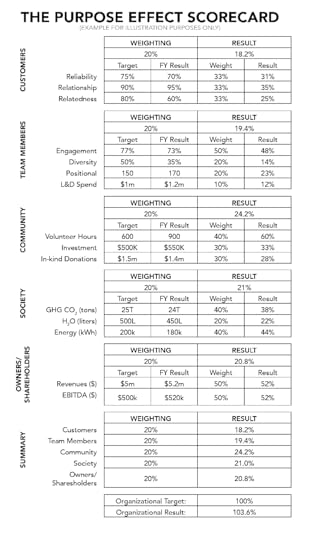
Dan's Related Posts:Three Tough Questions Answered About PurposeMy TEDx Talk on The Purpose EffectBook Excerpt: The Purpose EffectPurpose: The Word of 2016My Hopes for the Drucker Forum #gpdf14
June 2, 2016
How I Nearly Ruined My Personal Purpose
 Originally posted to Psychology Today.
Originally posted to Psychology Today.
The expression “low man on the totem pole”—a colloquial expression signifying someone of little importance—is actually irrelevant in First Nations culture. I argue it should become irrelevant to our thinking as well.
Figures on any totem are not arranged in a specific hierarchy and the most important figure can sometimes be the lowest one. One thing I have learned is that we ought to be unwilling to easily accept things for what they appear to be.
Let’s investigate another metaphor. One might hear the adage, “canary in a coal mine” to signify the unlucky plight of what is arguably one of nature’s most charming birds. Canaries are acutely sensitive to gases such as carbon monoxide and methane that harbor in coalmines. “Canary in a coal mine” is not simply a figure of speech. In days gone by, canaries were actually used to detect gas breeches in various coal mines. If the canary stopped singing—and thus died from toxic gas inhalation—the miners knew it was time to high tail it out of the mine to save their own lives.
I like to think of the canary as serving a wonderful purpose, gleefully singing to guard others. They were the miners’ protectors. They led a very meaningful life. Hence, when I hear the adage, “canary in a coal mine,” I think about it positively, not negatively. Canaries were indeed significant. In fact, they served an incredible, higher purpose.
The totem pole and coal mine canary stories provide us with a contemplative metaphor.
This is personal story. It is a tale where I forgot to listen to my own canary. I also overlooked the true meaning of a totem pole. Ultimately, it is a story where I lost my sense of self, my personal purpose.
It’s a long story, but it introduces the concept of personal purpose and how it is a never-ending journey for all of us, including yours truly.
The Greeks Meet Michelangelo
[image error]
I have redefined my personal purpose several times. It continues to grow, twist, and morph as I age. In fact, I turn 45-years old in June so I reckon I have another 45 years of personal purpose growth to look forward to.
I may have previously developed, defined and decided who I ought to be in life, but I have also recognized I have to continue the journey each and every day. I live and work with a purpose mindset, but I choose to do so daily, too. It’s a conscious choice. I do not leave it to chance.
There have been times in my life when I was stuck in a job-mindset, simply working for a pay check. Other times I thought the career ladder and a quest for power was what I ought to be achieving. Once I recognized where I was heading—counter to my personal purpose—my life entered into a state of mindfulness. I consider myself lucky. I consider myself to have reached a state of eudemonia, the Greek term for “human flourishing.”
The willingness to build and the quest to learn is key. Purpose is an ongoing voyage, a perpetual exchange with one’s soul. On one of his last sketches, Michelangelo allegedly wrote the words Ancora Imparo (I Am Still Learning), beside an old bearded man who sat in a go-kart with an hourglass before him. Learning, like purpose, ought to be pervasive and continuous. This steadfast belief has helped me in my life, my career, my leadership development, my purpose and with my relationships … including my most important one, with Denise, my beloved better half of twenty years.
Is The Grass Greener?
Occasionally there comes a time in one’s life when the question surfaces, “Is the grass truly greener over there?” Should I deviate from a purpose mindset in favour of a new job or career?
For example, perhaps you are happily married and love the city you live in. A recruiter phones you one day out of the blue. “Dan,” the recruiter says, “we’d like you to become the Chief Operations Officer of Big Time Corporation.” You sit there stunned, wondering what it might be like if you moved your family of five to New York, 5000 kilometers away. “The job starts in a month,” she continues, “and we’ll triple your current salary.” You think to yourself what you could do with all that money. Indeed, it is the chance of a lifetime.
But is it?
Is it the chance of a lifetime?
“The job starts in a month.” A job, you ask yourself? But I have found my purpose, why would I want a job? These sorts of dilemmas and questions arise from time to time for many of us. We must adjudicate whether more money is the ultimate quest. We must decipher whether a new city is the answer. We must sort out if the new (fancier) title and massive operational budget is worth the hassle. We must ultimately decide what makes us tick, between personal, organizational and role purpose. We must ask how we might achieve the sweet spot between all three.
We must ask whether we believe there is such a concept as being top of the totem pole. Is that canary still singing?
Such a situation played out in my family of five. This is the story I’d like to share with you.
The Island Move

In 2010, Denise and I purchased our first four-walled, free standing home in Vancouver, British Columbia. It was as posh a residence as we could imagine in the über cute neighborhood known as Kitsilano.
Three kids under the age of seven—we call them goats—each finally had their own bedroom. There was an actual basement, something foreign to us at the time.
The parents were settled. The children were attending fabulous schools. We thought to ourselves, “We made it!” We owned two cars, a shiny remodeled house, and possessed two great roles in what was our true calling in our chosen professions. The goats were healthy, and all of this was happening in Vancouver, one of the world’s greatest cities. Life was fabulous.
One Saturday morning in February of 2011—a mere eight months after moving into the new house—I read an advertisement in one of Canada’s daily newspapers, The Globe and Mail:
Wanted: Director of Academics, Saint Michaels University School, Victoria, BC.
I thought to myself, “Denise would be perfect for this. Too bad it’s in Victoria, 100 kilometers from here and on an island.”
I stoked the fire, sipped my latté and re-read the posting.
“Oh oh,” I muttered. “She would be perfect for this.”
Over the next few days, many discussions took place between Denise and I about crossing the proverbial pond known as the Georgia Strait, the body of water separating Victoria and Vancouver. Eventually the application was submitted, interviews were conducted and wouldn’t you know it, Denise was offered the position.
Denise initially balked at the job offer. “We can’t move to Victoria,” she said. “We just moved to this beautiful home and I like where I work right now.”
Victoria is a city located approximately 100 kilometers southwest of Vancouver. The population is roughly 400,000. Victoria is the capital city of the province of British Columbia, itself with a total population of roughly 3.5 million. That might seem like an easy move, however, the 100 kilometers is separated by the aforementioned Georgia Strait; a body of water that surrounds the eastern shore of Vancouver Island, the 32,134 km² mass of land where Victoria sits at its southern-most tip. There is no bridge, so to get from Vancouver to Victoria there is the four-hour downtown-to-downtown car ferry commute or the 35-minute float plane or helicopter service.
You could swim across, but there are Orca whales every now and then. It’s not advised. Just ask the seals.
Our family lives by a few mottos. The first: “Everything always works out.” Call us the eternal optimists. Another motto: “Never run out of wine.” Denise gleefully accepted the role, bought more wine, and we embarked on a new set of memories in Victoria.
The move and her new position was not about more money nor was it about a fancier title. We wanted to create an experience where our children—the goats—could go to the same school as their working Mom. “Life is for living,” another of our mottos, was being put into effect so we might as well get out there and live some more.
Island Fever Sets In
The first 6 months were outstanding. Everything was new and exciting.
The goats were settling in as if they had been born in Victoria. Even the Mayor came to our new house to welcome us. The Mayor!
But in March of 2012, I began to feel uneasy. In hindsight, I entered into both a closed and fixed mindset about Victoria and our family situation. The unrelenting gale force winds slamming the Island that winter did not help. But that was merely an environmental factor; I had inflicted psychological damage on our family and myself simply because I was not being open, flexible or demonstrating a growth mindset.

I was becoming a curmudgeon, much like those old guys who occupied the upper balcony on The Muppets.
I had lost my personal purpose to the fault of no one other than myself. I had manufactured my own negativity. I had manufactured my own lack of meaning. I was not only acting sorrowfully, Denise and I were having a wretched time in our relationship.
As 2013 began, the conversations between us opened up to the point of contemplating a full-time move back to Vancouver in the summer of 2014. It was less a conversation as it was a desperate plea from me to Denise. “We must go back to Vancouver,” I appealed to Denise. “I can’t stand it anymore in Victoria.”
Did you notice the shift from “we” to “I” in that sentence?
The decision “we” finally made in the summer of 2013 was to move back to Vancouver in the summer of 2014. This decision set off a series of conversations, not the least of which was the one Denise had with her Head of School in the middle of December, 2013, informing him of her resignation, set for June, 2014. She described his face as ‘white’, body language as ‘forlorn’ and verbal response as ‘shocked’. I wasn’t surprised— Denise is the ultimate professional and consummate team player. Who would ever want her to leave?
But something did not feel right.
I could see in Denise’s eyes that she too was white, forlorn and shocked.
What was I doing? Questions began to circle in my mind.
The Head of School indicated he would inform the staff and faculty of our departure on January 6, 2014. The plan was set, and now clearly in motion.
But something still did not feel right. The questions began to dog me.
Denise took 10 year-old Claire out for some Mommy-Daughter time on December 23, 2013. Denise used this as the moment Claire would be told of the move back to Vancouver. Lead balloons have had more success flying than how that conversation went. Needless to say, Claire was extremely upset and confused about the ‘why’. The word ‘crushed’ comes to mind.
Next up were 8 year-old Cole and 6 year-old Cate. Claire stopped Denise and I in our tracks advising us to let them know on Boxing Day instead of the 23rd so that “their Christmas would not be ruined like mine.”
Over the holidays we began telling close friends and family of our decision. When the Head of School informed the staff and faculty on January 6 at an all-school meeting, I cannot imagine what Denise was feeling at that moment in time. What I pictured, however, was that her heart was being ripped from her chest, displayed for all to see.
The Defeat of Agony
The Vancouver-bound plan now needed a plan itself. We had informed everyone of the move, but the strategy to actually inhabit the city again had not even begun. We had a house to move into, but Denise needed a job and the goats needed a school. That’s when things became emotionally surreal.
Here we were, a lovely family of five with 80 percent of the family content and in an absolute perfect situation with Victoria. The other 20 percent (me) was being a selfish jerk (me), yet we plodded on. Denise began conversations with three schools in Vancouver for a new role and we began the process of submitting school applications for the goats.

To put it bluntly, our purpose had been purposefully extinguished.
There really was no need to move. The canary had been singing a beautiful tune, but for whatever reason, I was deaf to it.
In retrospect, I also forgot about the totem pole.
I was determined to be on the top of it. I was flexing my muscles in spite of the totem laughing at my naivety. At the same time, my dear canary was gasping for air.
For about six weeks, the ordeal became extremely nauseous. During this time period, I travelled to Toronto, Calgary, Vancouver and Paris for various work events. Throughout the timeframe and when we were face-to-face, Denise and I only ever had “what do we do now” conversations. Various combinations and permutations were discussed. Certain goats began to be admitted into certain schools, whilst certain other goats were coming up short. Denise was busily discussing cool job opportunities (and offers) with schools but nothing was coming close to what Victoria presented.
Four years to the day almost, I was reading the Careers section of The Globe and Mail when I saw a job posting:
Wanted: Director of Academics, Saint Michaels University School (SMUS), Victoria.
I thought to myself, “Denise would be perfect for this … and isn’t it cool the role is based in Victoria.”
On Thursday, February 13th I was returning to Victoria from Paris and on the morning of, I woke up early and called home to speak with Denise on her Wednesday night. The nine-hour time difference helps. “Denise,” I said. “I get in at 8:00pm … can you and the goats pick me up? I want to be one of those Dad’s that have their entire family at the airport to greet them when they arrive back from a long trip.”
Denise responded, “Of course … see you there.”
The long trip home aboard various flights had me thinking how I might finally enter into an open and growth mindset about Victoria. I knew Denise’s school was interviewing for the new Director of Academics, but if we could prevent a decision from being made somehow … could we right the wrong?
Could we repair the personal purpose that was being overlooked?
Would the canary ever sing again?
Personal Purpose Resurfaces
When I got off that final airplane and saw all four of them at the Victoria airport, I could not have been happier. Thankfully, I could not have more clearly rediscovered (and redefined) my personal purpose.
As I entered the arrivals doors I was sobbing. Like a newborn in need of a meal. The only thing running through my mind was how selfish and self-centered I was being, causing such egregious pain to the four most important people in my life.
Flowers were sent on February 14th to Denise’s office, but it was the next day on Saturday, February 15th when we had our most heartfelt conversations about our future. The entire day was one of … “what if we didn’t move, what if you got your role back (the one you love) … what if the goats remain at SMUS?”
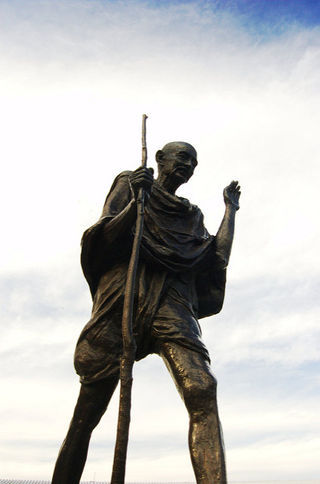
In hindsight, it was easily the most cathartic day of my life.
By 7:00pm that Saturday night, Denise phoned her Head of School and asked if he wouldn’t mind rehiring her, and readmitting the children to SMUS.
In a true act of understanding, his answer was: “I didn’t want you leaving in the first place. Consider it done. I’m so thrilled.”
By the time a celebratory bottle of Prosecco was guzzled by Denise and I, we looked at each other with eyes of relief, love and above all, each of our personal declarations of purpose re-established.
In the end, the canary came back to sing a beautiful tune. I actually went to a First Nations art shop and bought a new totem as a reminder that leadership comes at any level, at any moment in time. Purpose is not to be forgotten. I almost did.
Gandhi once wrote:
I claim to be a simple individual liable to err like any other fellow mortal. I own, however, that I have humility enough to confess my errors and to retrace my steps.
In summary, personal purpose is a lifelong journey. All of us will go through moments where we might not be listening to the canary, or we might mistakenly think we should be climbing the totem.
If we are humble enough to recognize we might have to go backwards a few steps in order to move forward, personal purpose will always be within reach.
Originally posted to Psychology Today.
 ___________
___________
More to read in my latest book, The Purpose Effect: Building Meaning in Yourself, Your Role and Your Organization
Dan's Related Posts:Walking the Talk of Being an Open Leader With My ChildrenTwo Very Incredible & Courageous WomenWhat I Learned From My Daughter About Decision MakingWhy I Wrote “The Purpose Effect” BookCool Contest: Win 1 of 10 Free Copies of The Purpose Effect



